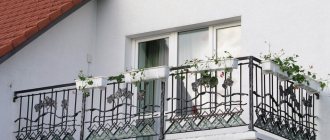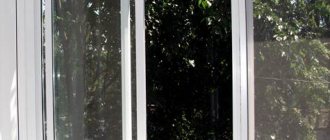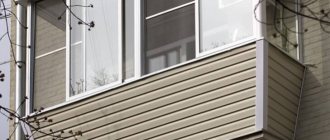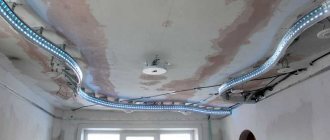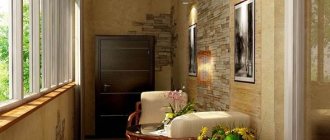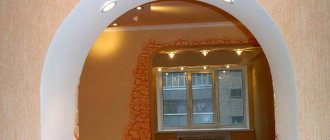If there is little space in your house and you would like to enlarge the room (at least visually) due to additional premises, then the best solution would be to equip a loggia.
A similar need arises for those who live in a small apartment, but want to increase the area of one of the rooms. Usually this is a living room, which is significantly expanded by combining a loggia and living space.
Naturally, each specific case requires separate calculations, since houses differ from each other, as do their execution projects.
Which extension method should I choose?
An extended balcony can have any size (within reasonable limits, of course) and any shape. For example, the “butterfly” technology involves extension along trusses attached to the facade on both sides at an angle of 45 degrees. However, two other methods of removal are considered the most popular at the moment - on the slab and on the windowsill. When expanding using these technologies, spacious and cozy remote balconies are obtained. Photos of structures mounted in different ways can be viewed in our gallery.
The method of expanding along the window sill is also called “kerchief”. In this case, the glazing is moved beyond the parapet. This method can expand the room by about 30 cm on each side. This is an easy-to-use and inexpensive method of removal, which involves installing the glazing on strong brackets attached to the parapet, or on a frame welded from the floor. The result is a fairly spacious remote balcony.
Extension along the window sill using steel brackets
The second method - carrying it out over the slab is much more complicated in execution, and therefore we will consider it in more detail.
Expansion along the slab
So, how to expand a balcony along a slab? This technique allows you to significantly increase the floor area. In this case, the work is carried out in several stages:
- The first step when expanding is to cut off the old parapet;
- Next you need to build up the frame of the supporting slab. To do this, channels are recessed into the wall above it and on both sides of the base (at least 25 cm), which are then connected to each other with steel corners. In this way you can make a fairly significant expansion of the base;
- A new parapet made of steel angle is being installed over the already installed frame;
- The area that is outside the old slab is riveted with tin or covered with any other suitable material.
- The new floor is covered with boards;
- The parapet is being finished;
- The frame is welded under the glazing.
General view of the frame when expanding along the base slab
Extending a balcony along the base of a slab is a procedure that usually requires obtaining permission from the relevant authorities. The fact is that an increase in length or width by more than 30 cm is equivalent to redevelopment.
Extension of the balcony along the base of the slab: stages of installation work
Since the method of such expansion is quite complex in its technological implementation, it needs to be given attention and more time spent studying it.
The technique of expanding along the base of the slab significantly increases the floor area and is performed in several stages.
The method of increasing the balcony along the base of the slab involves expanding the floor area
Stages of expansion along the slab:
- First you need to get rid of the old parapet.
- It is necessary to make a frame for the load-bearing slab. The bases must be deepened into the wall using channels 15 cm or deeper. After this, you should connect them with steel corners. This method makes it possible to significantly increase the area.
- A new parapet made of steel angle is installed on the removed frame.
- The area that extends beyond the old slab must be riveted with tin or other convenient material.
- The new floor needs to be covered with boards.
- Finish the new parapet.
- Weld the frame onto the new glazing.
The technique of expanding the balcony along the base requires additional hassle in preparing documents and obtaining permission. If the expansion exceeds the permissible limits, it will be considered a redevelopment of the apartment.
Glazing of balconies during removal
The glazing of extended balconies and loggias, just like regular ones, can be “cold” or “warm”. In the first case, aluminum frames are used. In the second - PVC or wooden profiles.
How to glaze a balcony with floor extension
When expanding along the base, “warm” glazing is usually performed. That is, the premises can subsequently be used in winter. Since expanding balconies in this way involves installing a new parapet, as well as a frame above the slab, the resulting structure is distinguished by the highest degree of reliability, as well as the ability to withstand significant loads. The technology for installing PVC profiles on an expanded slab is no different from the method of installing them when equipping a regular balcony. The racks to which the profile is attached are also welded.
However, at the same time, increasing the balcony along the slab provides the opportunity to choose a more spectacular original design. For example, French glazing can be called very interesting. Due to the peculiarities of the profile installation scheme, this method is mainly used only when carried out along the slab. The fact is that when installing double-glazed windows using this method, several centimeters of the internal area are “eaten up”. Extending balconies allows you to create spectacular glazing without losing space.
Floor-to-ceiling glazing when extended along the load-bearing slab
The essence of the method is that PVC profiles (or any other) after removing the frame are installed to the entire height of the balcony. Of course, such a restructuring requires some experience in installing Euro windows. A double-glazed window with built-in blinds is installed at the bottom. During operation, they can be closed, thereby creating an opaque “parapet”. A variety of types of glass (tinted, frosted, stained glass, etc.) can be used in the design. Of course, if you have “direct” hands, you can arrange such a balcony with your own hands.
This design requires the welding of a durable metal frame onto which the glazing profiles are attached. The safety of the apartment owners will depend on its reliability. How many centimeters to remove is a question, in this case depending on whether the owners want to expand the floor or just cover the “eaten” centimeters. Of course, it is better to immediately make the takeaway thorough.
Making a new parapet may become an unnecessary procedure if the old one does not spoil the appearance of the balcony. In this case, you can not dismantle it, but simply carefully paint it. Or order a beautiful decorative one and place it in front of the glass. This way you will get a rather aesthetically pleasing French glazing of the balcony with an extension. The photo clearly demonstrates the effectiveness of this design:
Decorative forged parapet on the “French” balcony with extension
A characteristic feature of such glazing is, first of all, the absence of the need for insulation of the parapet. Basalt wool or polystyrene foam is laid only on the floor and ceiling. The double-glazed windows are sealed, and therefore the balcony will be “warm”. Finishing is also carried out only on the floor, part of the facade wall and the ceiling. If desired, you can arrange a balcony with a roof made of transparent material, for example, polycarbonate.
Glazing when expanding along the window sill
Balconies with sill extensions are usually equipped with lightweight aluminum frames. In this case, a very important step is the calculation of the frame. The drawing is carried out taking into account all the design features of the balcony itself, as well as the type of future glazing. Aluminum frames usually weigh much less than PVC or wooden frames, and therefore place less stress on the modified parapet.
Some apartment owners are interested in the question of whether it is possible to increase the balcony along the parapet by a very large distance. Experts do not recommend making the extension more than 40 cm in this case. With a greater distance, there is a risk of the structure collapsing after glazing. The frames are installed on a profile that runs along the outer contour of the frame.
Glazing using aluminum profile when expanding along the window sill
Glazing of balconies with extension (photo can be seen above) if heavy PVC or wooden profiles are used, requires the installation of additional fasteners. At the same time, racks made of angle steel are welded onto the corners of the external contour profile, as well as at the corners along the wall. A metal circuit is mounted on top. The posts located inside the balcony are securely attached to the wall with anchors.
Thus, it is better to carry out the removal of a balcony with PVC glazing or using wooden Euro-windows along a load-bearing slab. Moreover, the French method has become very popular recently. When installing “cold” glazing, it is worth making an extension along the window sill.
How to get it?
The loggia remains isolated from the living quarters, but the walls will still undergo partial dismantling. Instead of them and small windows, sliding glazed doors will be installed, which will occupy the entire opening. This solution will create the impression of unity between the room and the balcony.
Glazed doors leading to the loggia
Ideally, it would also be to demolish the entire wall between the kitchen and the room, but for safety reasons this idea will have to be abandoned. Therefore, we leave part of it to accommodate the TV, and fill part of it with a folding partition that resembles a screen. We leave the living space practically unchanged and get a studio.
A special feature of the interior is the abundance of natural light. It is emphasized and enhanced due to the dominance of light colors in the decor of the room. An interesting solution was to replace part of the wall with a folding partition in the form of blinds. It allows you to view the entire apartment from anywhere without taking up much space.
Space between kitchen and living room
A large mirror visually expands the space of the apartment. On the one hand, it is a closet door, and on the other, it is a partition between the hallway and the bedroom (if necessary). That is, the door opens towards the front door, allowing residents of the living space to evaluate their appearance before leaving.
The big problem was the design of the adjacent bathroom. This tiny space was half occupied by sewer system components. It was decided to first bring all this into a decent form - update, repair, and then cover it with one large panel. To the left of it there is an oak cabinet. A toilet with a modern flush instead of a standard tank and a sink were built into it. A small shower stall was placed between the riser and the doorway.
Decorating a small bathroom
Stretch ceilings helped hide the ventilation pipe in the apartment; they tried to place it as close to it as possible, thereby not narrowing the space too much.
Lighting in the apartment is now provided by LED bulbs with a slightly larger diameter than usual. This is because the city in which the property is located is often dominated by cloudy weather, so warm, soft light is ideal for local interiors. Designer chandeliers and sconces act as color and semantic accents.
Natural room lighting
And now the most important thing - the loggia. It can be roughly divided into two parts. There is a bookcase on the left, and a comfortable trestle chair on the right. The balcony is glazed using frames of the largest possible size for its design. They also help to visually increase space.
Loggia furnishings: couch and bookshelves
In addition, there is a folding table on the balcony, where you can sit with a cup of tea or coffee and enjoy the natural scenery outside the large windows. Above the couch there are bookshelves on which apartment owners can store books they are currently reading or put aside for the future. The color scheme is based on the contrast of red, blue and yellow shades, which creates coziness and provides comfort to the eyes.
Folding table and bookcase
Increasing the space of an apartment is not at all difficult. The most important conditions for success are a creative approach and a desire to change something on the part of the residents. A few simple ideas and ingenuity will help expand the space not only visually, but also actually, especially if the apartment has a small balcony that can be turned into an independent room.
Balcony extension
Expanding the balcony is a popular procedure today that allows you to increase the area of the room.
The owner of an apartment in Khrushchev may have a desire to expand the premises, since the area there is small, and the presence of a balcony is a good way to increase it. You can enlarge the room yourself or by turning to professionals for help.
Light work that does not require additional permission is carried out independently. For example, such a procedure as increasing the window sill with certain knowledge and skill is quite accessible to any person.
In old houses, even minor changes need to obtain permission from the relevant authorities. In the “Khrushchev”, by law it is allowed to increase the balcony on all sides by a maximum of 50 cm. There are cases when the increase was carried out over a greater distance. Without obtaining permission, you can expand by 15-30 cm along the base of the slab.
Professional consultation is required for any significant design changes. All stages of increasing the balcony floor and replacing the parapet must be carried out in high quality and with high-quality materials.
Choosing a room expansion method
Currently, PVC plastic windows are very popular, especially among residents of large cities, as they reliably protect against noise, drafts and dust, are reliable, modern and beautiful.
If you are seriously thinking about such a construction experiment, then you have three options:
- glazing (without auxiliary heating);
- glazing with heating;
- combination with the room.
The third solution is to remove the wall between the balcony and the room. Such construction work represents a redevelopment of the apartment premises; they must be approved in advance (after this, all changes in your living space will be reflected in the technical passport).
Getting permission
In some cases, to reconstruct a balcony, you need to obtain permission from various organizations: design organization, BTI, Gorekspertiza, Ministry of Emergency Situations, fire inspectorate and others.
- If the house in which the balcony is being expanded is an architectural asset, its future appearance must be agreed upon with the relevant organizations.
- Installation of a concrete base is considered redevelopment. In the case of installation, you need to obtain permission regardless of the size of the balcony increase.
- In Khrushchev, permission must be obtained if the expansion is made by more than 50 cm.
- The balcony fencing is attached to the walls of the house, so the condition of old houses must be checked before reconstruction.
- In addition to the size of the balcony increase, you need to pay attention to the weight of additional structures. If large loads are expected on the walls of the house, then the procedure also needs to be agreed upon by various authorities.
- All checks before expanding the balcony are carried out for the sake of safety and comfort: your own and those around you.
Despite the fact that the balcony is part of the apartment, that is, personal property, it belongs to the common property of the house. Its changes affect the appearance of the house. Enlarging the concrete base can limit light access to neighbors below. Errors in work can lead to cracks in neighbors’ walls and other undesirable consequences.
Therefore, in addition to agreeing on all the requirements according to GOST, you need to discuss the project with your neighbors.
Extension along the window sill
Expansion can be done by increasing the outer window sill. In this case, the base of the balcony is not expanded, but an inclined structure is installed, which goes from the floor to the enlarged window sill.
The walls of the balcony can ultimately be not only inclined, but also rectangular or any other, that is, look like a ledge. This expansion creates the appearance of increased space, and at the same time the wide window sill becomes an additional place where you can put things, place pots of flowers, etc.
Extension along the window sill does not involve increasing the floor, so permission is only needed if the house is old and requires inspection.
Often such an expansion is made during glazing and cladding of the balcony as a design option and additional convenience.
- In addition to this visual expansion, you can add panoramic glazing, which will allow a lot of light into the room, and, therefore, the room will look larger.
- The base of the future window sill is created strictly according to the level.
- If the fence is metal, then the structure is welded to it, and the concrete fence is connected to the structure using anchors.
- After the structure is installed, the window sill is installed, covered, finished with selected materials and glazing, if planned.
Extension by floor
Extension along the floor is much more difficult to perform than along the window sill.
- Increasing the floor involves dismantling the concrete base, for which permission must be obtained.
- If dismantling is not carried out, but a future floor structure is installed on the base, not exceeding half a meter on each side of the base, then permission is not required.
- To begin work, the parapet or old structure is removed, and the concrete base is repaired or dismantled. A durable metal structure is installed on top or around it, which is attached to the concrete and walls of the house using anchors. A metal pipe is used for reinforcement.
- After the structure is installed, cladding, finishing and glazing are carried out.
Butterfly
Butterfly technology is another way to expand the room. Additional space is created by triangle-shaped blocks, which are located on both sides of the balcony.
This design can be created by expanding the window sill and floor.
- In one case, a solid structure is created by increasing the floor and adding two side window sills. The bases of the window sills are attached to the wall of the house and the main overall structure.
- In the second case, the floor is not increased, but window sills are added to the overall structure.
The “butterfly” technology, as well as the expansion along the floor, can include not only the free space around the house, but also the windows of other rooms. This choice depends on the internal layout and interior of the apartment. During the general redevelopment of the apartment, the lack of light can be compensated by increasing the window opening.
Corner designs
Corner design is a rarer option for expanding a balcony. It can be carried out by the owners of those apartments that are located in the corner parts of the house or in private houses.
An extension can be considered an increase in an already existing corner balcony by creating an additional part of the balcony using any of the first three methods.
Formal side of the matter
Enlarging a room with a loggia or balcony is not just a remodel. According to legislative and building standards, this is nothing more than RENEWAL of an apartment. Moreover, the redevelopment is COMPLEX. Here is a list of cases when, according to building regulations, redevelopment is considered complex. The interpretation is similar to the approach of psychiatrists to schizophrenics: any of the “first degree signs” means a diagnosis. So:
- relocation of doorways;
- punching openings in load-bearing structures;
- disaggregation of multi-room apartments;
- partial demolition of load-bearing structures;
- changing the size of bathrooms, kitchens, rooms and corridors;
- moving a bathroom or kitchen;
- installation of additional bathrooms or kitchens;
- combining a bathroom with a toilet;
- combining two or more apartments;
- expansion of the apartment by adding auxiliary premises;
- installation instead of gas household electric stoves;
- installation of additional ventilation ducts;
- transfer of electrical networks, gas and heating plumbing fixtures, etc.
According to criteria 5 and 10, joining a balcony or loggia to a living space certainly fits the classification. If it is planned to increase the opening of the balcony block, then signs 2 and 4 are added - the balconies do not open from the hall to the nursery. What follows from this? The fact that you can’t get by with a handwritten sketch signed by the chief engineer of the DEZ. Coordination of the work in its entirety and permission to carry it out are required.
And keep in mind: you need to go through all the formal red tape before you even hit it with a hammer. Starting work without registration is an undeniable reason for claims from authorities or outside ill-wishers. Simply: if a harmful neighbor “knocks”, which you have already knocked, the formal truth is on his side, and you have nothing to say in justification, and penalties are inevitable.
Documents for connecting a balcony
To turn a balcony into additional living space, you must first prepare the following package of documents (hang in there, comrade!):
- a completed application form for redevelopment of an apartment in the form approved by Decree of the Government of the Russian Federation of April 28, 2005 No. 266;
- certificate of ownership of the apartment or warrant;
- written consent of all capable family members in any form;
- acts of consent from neighbors below, also from all capable;
- acts of consent from capable neighbors above, if you have a common balcony slab with them;
- for municipal housing - written consent of the head or chief engineer of the DEZ for redevelopment;
- for a rented apartment in an apartment building - the same from the owner of the building or its operator;
- conclusion of the body for the protection of architectural, historical and cultural monuments on the admissibility of redevelopment (for apartments located in a building that is a cultural or architectural monument).
Let’s look at the “slippery” points:
Point 2
A certificate of family composition indicating the responsible tenant, as for re-issuing contracts for utility services, is not accepted. We need a warrant according to which the apartment was occupied. Lost? We write an application to the DEZ, wait six months to see if an outside applicant for this living space appears, and we get a new one. It’s good if the family is small and the occupancy rate is exceeded: you don’t have to fear the machinations of “housing hunters” who have “everything covered” in the authorities.
Points 4 and 5
“Neighbors”, according to the law, are not just Uncle Kolya and Aunt Liza, but everyone who is registered in their apartment. If one of them (a real case) is a second cousin who works as a trawl master on a seiner based in the port of Kurilsk on the island of Iturup in the Great Kuril Ridge and is on the voyage 8 months a year - you cannot do without his permission, written and written in his own hand. If the officials in the authorities at heart are not alien to maritime romance, then the consent certified by the captain over the radio may do: he is also endowed with the functions of a notary at sea. But it’s up to the “authorizers” to interpret the law in their own way.
And again, we take into account the state of public morality at the current moment. You may be greeted cordially, listened to with full understanding, and then, with a kind face and a benevolent smile, be told how much you should pay in exchange for his signature. There is no point in being indignant or complaining: in his own home, such an extortionist is a private person, and the required tribute is compensation for the inconvenience of the work being performed.
Point 6
There are no regulatory documents prescribing in which cases the relevant officials should certainly issue such permits: if there are no obvious reasons for refusal, then it is at their discretion. Comments are unnecessary, no explanation required. In general, establish and maintain good relationships, taking into account your personal inclinations. Not entirely ethical, but cheaper.
Point 7
As a rule, a permit is issued upon presentation of a contract for work with a construction company that cooperates with the owner or belongs to him. Of course, no one will directly declare this in advance and no one will set such conditions. Doing the work yourself is your full right and your choice. Problems too.
Clause 8
Let's not talk about the really sad stuff: the relevant bodies are chronically underfed from the budget, and the salaries of their employees... once again: comments are unnecessary, no explanations are required. However, it is still appropriate to highlight two points:
- Since remodeling the balcony will certainly affect the architectural appearance of the building, the chances of obtaining permission are slim.
- If, nevertheless, “the fairy tale has become reality,” the innovation in the appearance of the building will not escape the attention of regulatory authorities and public activists, and the successful completion of the work will be the beginning of a series of troubles. Possibly - heavy, because according to the law, the bribe-giver bears equal responsibility with the bribe-taker
"Permission" package
But this is only a saying, and the torment still lies ahead. Based on the initial package you need to get the following:
- Technical passport of the apartment, issued in the BTI (floor plan, explication, certificates f.1a and f.5).
- Redevelopment project prepared by a licensed design organization.
- Technical conclusion on the possibility of carrying out appropriate redevelopment of residential premises.
- Conclusion of the Russian Ministry of Emergency Situations (fire service) on the possibility of redevelopment.
- Conclusion of Rospotrebnadzor (SES) on the possibility of redevelopment.
- Approval from the author of the house project or an authorized architectural organization.
- A notarized copy of the certificate of ownership of the premises.
- Unified housing document.
- Approval of the organization on whose balance sheet the house is located: REU, DEZ, management company, HOA.
- An agreement for technical supervision of construction work with an organization that has a license to carry out this type of activity.
General note to the list: the validity of certificates and conclusions is limited, the queues are long, officials are not eager to satisfy the requests of the population. As a result, be prepared for the fact that in the middle of the journey you will have to start something, or everything, over again.
And only after completing all the rounds can the final package be submitted to the municipal interdepartmental commission (IMC); in megacities - to the district interstate complex. She gives the desired permission. If everything is done correctly, no questions arise.
However, there is one last slippery point here: it is not specified anywhere how the IAC should calculate the validity period of certificates: from the moment of issue or from the moment of submission by the applicant? Since the queues here are huge, and the work is really overwhelming, they count from the moment of issue, and there is nothing to cover (?).
How to increase the balcony with your own hands
Article Photo Video
Often, a balcony in typical high-rise buildings raises questions about the purpose of its creation. Conceived by the designers as part of the exterior and interior comfort of the building, this element still requires improvement. For this purpose, the opportunity to increase the balcony area and thereby expand its functionality is used. In this way, the apartment owner can create additional space: an office, a recreation room, a greenhouse, etc.
Attention! Expansion of the balcony from the facade and ends by more than 0.3 m requires approval from the relevant authorities.
The idea of increasing the balcony with your own hands is quite feasible, especially if you have experience in welding and a smart assistant. Materials are selected depending on the point of removal, having previously created a project (drawing) of the future structure. Two structural methods of expanding the area are widespread: from the load-bearing slab (sole) and from the parapet (upper level of the railing). The first method is more labor-intensive, but allows you to get an additional 2 square meters. m area.
Advice! Before you begin to increase the area, it is worth familiarizing yourself with the safety precautions for welding and high-altitude work.
Step-by-step removal from the load-bearing slab
The method allows not only to enlarge the balcony in the Khrushchev-era building, but also to make a major overhaul of the load-bearing slab, the condition of which, as a rule, leaves much to be desired.
- Using a grinder and a hammer drill, the old railings, previously tied with a rope (to prevent falls), are dismantled.
- On both sides of the load-bearing slab, channels are mounted into the wall at the level of the length and width of the frame. To strengthen the sole, metal profiles are also hammered above it.
- The ends of the elements are connected with a steel angle along the load-bearing slab and at the ends of the driven beams.
Advice. If there are doubts about the reliability of the sole, then it is necessary to install additional supports. When increasing the balcony area on the second floor, they are installed in the ground, provided that they do not disturb anyone. If the balcony is on the ground floor, then, in agreement with the administration, it is possible to equip a cellar, the brick walls of which will be a reliable support. On the remaining floors, “heels” are additionally attached under the load-bearing slab.
- A new parapet is welded from steel strips.
- The floor is mounted - metal strips are welded to the frame, to which sheets of galvanized sheet are attached. If desired, lay polystyrene foam, mineral wool (any insulation material), then cover it with boards.
- Weld the frame for the glazing and the canopy.
- Install the canopy, which should protrude 0.3 m above the parapet.
- The balcony is glazed, the roof, walls and parapet are insulated. They produce external and internal finishing.
How to expand a balcony in a Khrushchev building: work order
Houses called “Khrushchev” were built quickly and not of very high quality. They are not large in size. The apartments feature small kitchens and narrow balconies. Today there is an opportunity to at least slightly increase the living space of such an apartment.
You need to carefully prepare for the removal of the balcony, taking into account the fact that the balcony structure is quite weak and needs to be strengthened.
Today, it is legal to enlarge a balcony in a Khrushchev-era building by a maximum of 50 cm.
The lucky ones who finally received permission to enlarge the balcony enjoy its spaciousness and comfort
The procedure for carrying out work to increase the balcony:
- Dismantle fencing and structures. The base cannot be dismantled.
- Recesses are made above the load-bearing wall in order to attach channels that will become the base. At this stage, you can begin to enlarge the balcony in all directions. On average, it will be possible to increase the balcony by 40 cm. Care must be taken to ensure that the load-bearing wall does not overload.
- It is necessary to build a roof and do the sheathing. Particular attention should be paid to finishing joints and crevices to protect against moisture.
- An important stage is insulation. The following materials are usually used for it: mineral wool, polystyrene foam, styrodur. The latter has a number of advantages: it is moisture resistant and has good thermal insulation properties. It is also better to use styrodur to insulate the balcony floor.
- The last stage is finishing and arrangement of the interior. Here you should not limit yourself to flights of fancy and experimentation.
When enlarging the balcony in a Khrushchev-era building, it is important to remember the fragility of this type of house. Therefore, it is preferable that all work is carried out by a professional who will guarantee the quality of his work.
Step-by-step removal from the windowsill
The expansion of the balcony, starting from the window sill, is carried out using two methods - using a frame or brackets. The frame is welded if metal structures serve as the parapet. In this case, a preliminary calculation of the strength and weight of the structure, taking into account the glazing, is also necessary to avoid unnecessary load.
Extension from the parapet using a frame
- The supporting plate is reinforced with a metal profile - the sole is scalded with it. The old railings are cut off and the parapet bars are reinforced with spacers.
- Jumpers of the length by which the area is planned to be increased are welded onto the railing every 0.4 m (approximately).
- By welding a steel strip to the ends of the jumpers, they are combined into a circuit.
- Install external spacers connecting the load-bearing slab and the contour opposite the window sill.
- The frame for the glazing and the canopy are welded and installed.
- They carry out glazing, insulation, exterior and interior finishing.
Extension from the parapet using brackets
The method is used if the parapet is made of a concrete slab or brickwork.
- Steel brackets, welded independently from angle or steel strip, are attached to the parapet with anchors or bolts at an angle of 90°. If you plan to use summer glazing using a lightweight aluminum profile, then installing corners instead of brackets is acceptable.
- The brackets are combined with a steel profile, creating an external contour.
- Glazing and finishing works are being carried out.
Advice. To determine the evenness of the surface, it is advisable to use a long, 2-meter level - this will reduce the likelihood of problems occurring during further work (glazing).
Additional options
Warm glazing is always glazing with metal-plastic structures. Metal-plastic windows are ordered for glazing balconies if they want to have a constantly positive temperature on the balcony in winter.
- Cold glazing. This method is the simplest and does not require the owner to make any changes to the structure of the building or the thermal circuit. But in this case, the functions of the loggia will change dramatically.
- Warm glazing. Heating will bring you a number of possibilities, including organizing a dining room (if the balcony has access to the kitchen) or a study, mini-gym or greenhouse if the balcony has access to the bedroom.
Following the rules, the fencing material must be non-flammable and strong. After dismantling the original walls of the loggia, it is necessary to build new ones using brick, foam concrete blocks, and use metal as a frame. In the glazing process, use double-glazed windows and warm profiles, basalt wool, penoplex, polyurethane foam and other foil-type materials. The use of polystyrene foam for heating is not safe, since it contains an increased fire hazard (moreover, during combustion it releases toxic compounds).
Frameless way to increase a balcony from a load-bearing slab
This method is less labor-intensive than a frame method, and is ideal for independently enlarging a balcony in a Khrushchev-era building.
- The railings, parapet, and old screed are dismantled down to the reinforcement at the top and bottom of the slab.
- The base is primed. Using a rust remover attachment on a drill or screwdriver, the fittings are cleaned. After re-priming, the reinforcement is degreased with a solvent.
- Formwork for conventional or self-leveling screed is created on the load-bearing slab. The recesses on the bottom of the slab are sealed with finishing glue (you can also seal the slab from above, on a neighbor’s balcony).
- An enlarged base of the required length and width is cut out of OSB sheets 2.5 cm thick, as well as a roof, which are mounted to slabs with a layer of hydrobarrier film using anchor bolts. If desired, you can also make the sides of the balcony from OSB boards.
- Glazing, exterior and interior finishing work is being carried out.
Advice. Sheets of oriented strand board should be painted with water-based paint before installation to protect them from moisture. For facade finishing, you can use siding, corrugated board and other finishing materials.
Not everyone wants to use additional meters to organize a greenhouse, recreation area, etc. - some will prefer to enlarge the room by adding a balcony. In this case, partial or complete dismantling of the dividing wall and installation of a heating system will be required.
Attention. Any redevelopment requires the creation and approval of a project and obtaining permits. If only the window and balcony door were dismantled, and the window sill wall was left, then permission will still be required to move the heating radiator. Therefore, legitimizing alterations cannot be avoided, even “retroactively.”
It is also a good idea to enlarge the kitchen with a balcony - given that the kitchen space in Khrushchev-era apartment buildings is on average 6 square meters. m. Regardless of which room the balcony is combined with, it is worth considering a number of rules:
- before demolishing the window sill wall, the balcony must be glazed and insulated;
- the threshold between the balcony and the living space must not be dismantled if it holds the load-bearing slab;
- if the wall between the room and the balcony is load-bearing, then the upper lintel and side walls cannot be dismantled;
- You should not lay a warm water floor on the attached balcony - it is better to replace it with an electric one.
- Tinting of balconies and loggias
- Differences between a balcony and a loggia
- Beautiful fire escape on the balcony
- The balcony door does not close: reasons, solutions
Discuss the article on the forum We recommend
Popular posts
- Chair for dressing table Chairs for dressing tables in Moscow - 189 Products Company from Moscow, delivery 29643 a In…
- Silicone sanitary sealant Silicone sanitary sealant white in Moscow - 1491 products Company from Moscow, delivery (tomorrow) 140...
- Shelf in the hallway Currently, there are a huge number of different options for shelves in the hallway, and this is directly ...
- Insulation of the floor in a wooden Insulation of the floor in a wooden house from below: materials and installation technology SHARE ON SOCIAL NETWORKS One of the common…
Combining a room and a loggia
Sliding partitions consist of one or more modules, fastened together and not connected to the floor.
Redevelopment rules provide for the removal or modification of window and door openings in the walls of buildings only while maintaining the integrity of the structure. The owner can make a similar decision, but then he will need to find a project with thermal engineering calculations. Installation of sliding partitions is one of the solutions that will help maintain the thermal background between the room and the loggia.
It is also possible to enlarge the opening leading to the balcony using side walls. Panel houses make this procedure impossible, since the outer wall is load-bearing and curtain wall. However, you can get rid of part of the window sill by carefully cutting it off without damaging the working fittings. If your house is built of brick, then you can remove only the window sill near the load-bearing wall. In the case of self-supporting brick structures, the side walls may also be subject to removal.



